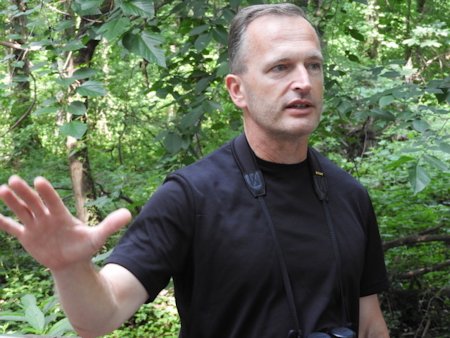On June 9, 2018, Dyke Marsh members and friends learned about Potomac River wetland ecosystems and the interrelationships of plants, insects, birds and other biota, on a walk on the Preserve’s Haul Road trail led by Charles Smith, expert naturalist and Chief of Fairfax County’s Stormwater Planning Division, Watershed Projects Implementation Branch. He also discussed human intervention and how native Americans used some of the marsh plants.
The Haul Road is man-made higher ground between lower elevations of the Dyke Marsh wetland ecosystem, Charles explained. Within 80 years, the Haul Road will likely be under water due to sea level rise exacerbated by global warming, according to several studies. The U.S. Army Corps of Engineers is doing a detailed study on this subject that should be out in two and a half years. This area was under a greater tidal influence in the past and will be again.
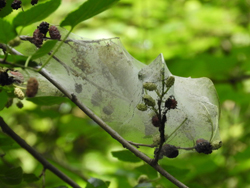 Eastern moth tent caterpillar, Malacosoma americanumWeb worms or tent moth caterpillars (Malacosoma americanum) are a native species important as food for birds like the chickadee and titmouse. The web of tent caterpillars protects the young, growing caterpillars as they develop, but when the caterpillars mature, birds are likely to pierce the web and eat the caterpillars or feed them to their young.
Eastern moth tent caterpillar, Malacosoma americanumWeb worms or tent moth caterpillars (Malacosoma americanum) are a native species important as food for birds like the chickadee and titmouse. The web of tent caterpillars protects the young, growing caterpillars as they develop, but when the caterpillars mature, birds are likely to pierce the web and eat the caterpillars or feed them to their young.
Native insects tend to not eat invasive species. When invasive plants push out native species, the insects that feed on them are lost. A basic ecological rule is that if insects cannot eat a plant species, they are not fulfilling an ecological role. It is the insects that get the energy from the trees out into the rest of the food web, a process called trophic transfer. Birds then feed on the caterpillars and the caterpillars are an especially important food source for birds that feed their young in the nests.
The efficiency with which energy or biomass is transferred from one trophic level to the next is called ecological efficiency.
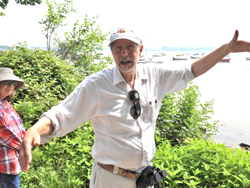 FODMer Barry Sperling discussed the cloud formations of the day.FODMer Barry Sperling discussed the cloud formations of the day. There was very high humidity which created a bluish and hazy air. The high humidity went up to 10,000 feet, Barry explained. He said that drier air is present at 10,000 to 16,000 feet. Above 16,000 feet, the air gets humid again. Weather forecasters predicted cold air from the northwest to come in and push up the warm humid air later in the day. High cirrus clouds typically provide moisture in the upper levels.
FODMer Barry Sperling discussed the cloud formations of the day.FODMer Barry Sperling discussed the cloud formations of the day. There was very high humidity which created a bluish and hazy air. The high humidity went up to 10,000 feet, Barry explained. He said that drier air is present at 10,000 to 16,000 feet. Above 16,000 feet, the air gets humid again. Weather forecasters predicted cold air from the northwest to come in and push up the warm humid air later in the day. High cirrus clouds typically provide moisture in the upper levels.
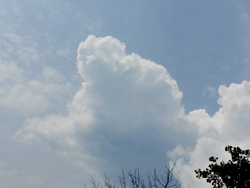 Cumulus congestus cloudCharles added that the plants are very busy pulling water from the ground and pushing it into the air through transpiration, adding to the moisture in the air.
Cumulus congestus cloudCharles added that the plants are very busy pulling water from the ground and pushing it into the air through transpiration, adding to the moisture in the air.
Heat of vaporization is released when moisture goes from gas to liquid. This causes the moist air to rise, resulting in more and more heat. The clouds can go up to 60,000 or even 80,000 feet in the great plains. In Northern Virginia, they rarely go above 40,000 feet because the conditions are not right for it, Barry commented. The pictured cloud is cumulus congestus and it is named cumulonimbus when rain is produced.
Photos contributed by Bob Veltkamp. Here are more of his photos from the walk:
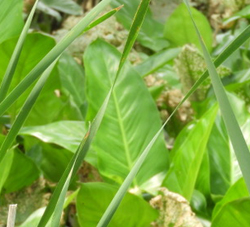 Arrow arum
Arrow arum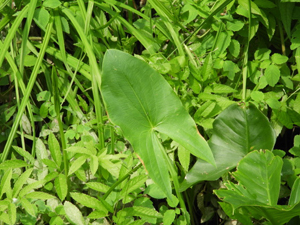 Arrowhead
Arrowhead
Two wetland plants, the arrow arum, Peltandra virginica, or duck potato, and the arrowhead, Colocasia esculenta, are easy to confuse. The veins in the arrow arum on the left radiate from a central line. The veins on the arrowhead all radiate from a single point.
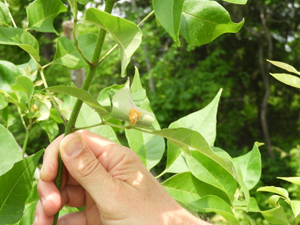 Pumpkin ash
Pumpkin ash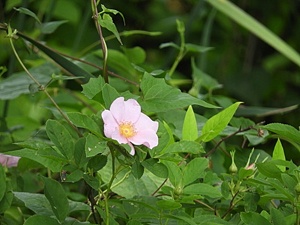 Swamp rose, (rosa palustris), a native wet soil plant, is not found in the very wettest soil.Pumpkin ash (Fraxinus profunda) is a native tree that is dominant in marshes. In Dyke Marsh, it was the dominant species covering large areas of the marsh. FODM has worked with the National Park Service to treat some of these trees to try to keep them healthy. There are large areas of dead trees in Dyke Marsh, especially to the south, that have died because of the non-native ash borers. This pumpkin ash in the photo has some fungus growing on a leaf.
Swamp rose, (rosa palustris), a native wet soil plant, is not found in the very wettest soil.Pumpkin ash (Fraxinus profunda) is a native tree that is dominant in marshes. In Dyke Marsh, it was the dominant species covering large areas of the marsh. FODM has worked with the National Park Service to treat some of these trees to try to keep them healthy. There are large areas of dead trees in Dyke Marsh, especially to the south, that have died because of the non-native ash borers. This pumpkin ash in the photo has some fungus growing on a leaf.
 Daisy fleabane (Erigeron annuus) is a native plant that is a spring and summer bloomer in Dyke Marsh. Daisy fleabane (Erigeron annuus) is a native plant that is a spring and summer bloomer in Dyke Marsh. |
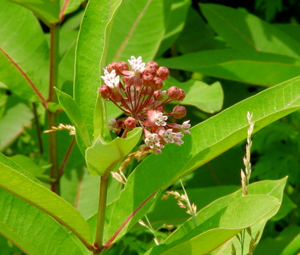 This blooming common milkweed (Asclepias syriaca) has broad leaves with a purplish midvein. It is a prominent host plant for monarch butterflies and many species of beetles. This blooming common milkweed (Asclepias syriaca) has broad leaves with a purplish midvein. It is a prominent host plant for monarch butterflies and many species of beetles. |
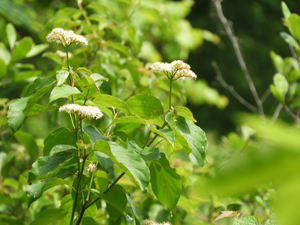 A common wetland plant is the silky dogwood, (Cornus amomum), a gray stemmed dogwood, which has leaves that have a minimum of five veins per leaf. A common wetland plant is the silky dogwood, (Cornus amomum), a gray stemmed dogwood, which has leaves that have a minimum of five veins per leaf. |
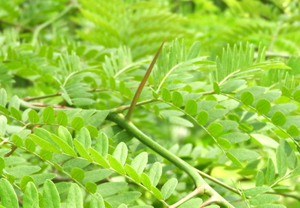 The honey locust (Gleditsia triacanthos) evolved long sharp thorns as protection from herbivores. The thorns protected the plants from things like like mastodons and other now extinct species. The honey locust (Gleditsia triacanthos) evolved long sharp thorns as protection from herbivores. The thorns protected the plants from things like like mastodons and other now extinct species. |
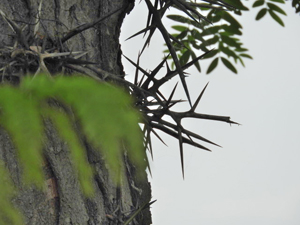 Honey locust thorns protect the tree. Honey locust thorns protect the tree. |
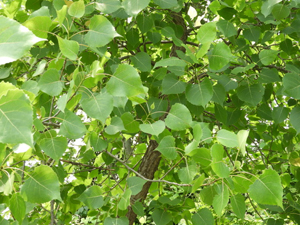 Eastern cottonwood (Populus deltoides) is a member of the aspen family. It has deep furrowing of the bark. The flattened leaf petioles shimmer in the breeze. This is a very common floodplain species. Eastern cottonwood (Populus deltoides) is a member of the aspen family. It has deep furrowing of the bark. The flattened leaf petioles shimmer in the breeze. This is a very common floodplain species. |
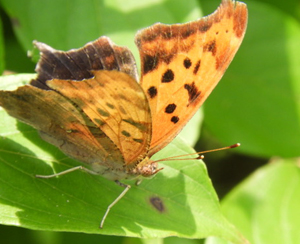 Comma, part of the Angel Wing family. Comma, part of the Angel Wing family. |

